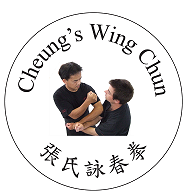www.cheungswingchun.co.uk 張氏詠春
Our first sporting hobby was fencing at Cambridge Fencing school in the 1980s. We got involved with Wing Chun later but quickly recognised, like Bruce Less who actually studied fencing to develop his JeetKeun Do Kung Fu, that there are a number of similarities between fencing and the art of Wing Chun.
To begin with, we can account for: the on-guard position, advancing footwork and the fighting distance.
On-guard position
The classic fencing on-guard foil position is an up-right posture with the torso about three quarter turn towards the opponent with the weapon’s blade presented 45 degrees to the horizontal to form a barrier. The whole guard is then supported by lowering the centre of gravity by bending the knees and having the feet in an ‘L’ shape stance. For the arms; the foil arm is bent at the elbow, approximately one fist distance from the torso while the other arm is held aloof in a relax state to provide counter balance to the posture.
In Wing Chun, the classic posture is very similar except the torso is more or less squared to the opponent with the hands covering the centreline. The arms are bent at the elbows with the Wu Sau’s elbow being approximately one fist distance from the torso. The whole guard is then supported by lowering the centre of gravity by having the feet in parallel, approximately 45 degrees to the opponent with the front leg in slight rotation to provide protection to the groin region.
From Wing Chun perspective, the classic posture being square to the opponent is how powerful blows are developed as the whole body would be behind the strike. For fencing, the three quarter turn is to present a minimum optimum target area for the opponent.
Advancing footwork
Both Wing Chun and fencing stress pushing from the rear leg when advancing. The sequence goes like this: bodyweight on rear foot, front foot is picked up a few inches off the ground as the rear foot is pushed forward with front foot landing followed immediately by the rear foot landing to maintain the starting distance between the feet.
For beginners, this often leads to a rocking motion of a rise and fall of the stance when advancing. This is not the attention for both Wing Chun and in Fencing. The aim is to glide much like a leading man performing the waltz, who pushes with the rear leg while maintaining good posture.
For retreating, the sequence is reverses. However in Wing Chun, it is rare to retreat in a straight line other than performing exercises. Wing Chun practitioner would instead move either to one side on even into the opponent’s space.
Fighting distance
In fencing, the fighting distance between the opponents seems very large. But it is in fact the actual distance required to hit the opponent is similar to Wing Chun’s fighting distance of approximately one arm length.
The major difference is how the fighting distance is handled. In fencing, the objective is to maintain this distance until an opening or an opportunity present itself. In Wing Chun, we encourage this distance be closed as soon as possible to limit the options the opponent can make.
